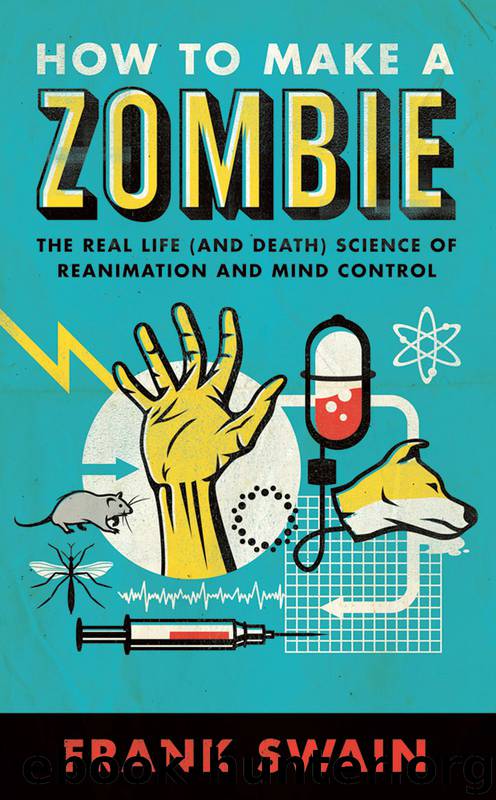How to Make a Zombie by Frank Swain

Author:Frank Swain [Swain, Frank]
Language: eng
Format: epub
Tags: bizarre inventions, brain science, Haiti, living dead, lobotomy, medical history, MK-ULTRA, near-death experience, odd experiments, organ donation, parasites, popular psychology, resuscitation, Russian science, science of death, science humour, Soviet science, Soylent Green, sperm donor, weird science
Publisher: Oneworld Publications
Published: 2013-05-19T16:00:00+00:00
Leucotomy was a delicate surgery, restricted to well-equipped hospitals – those best situated to do something rather than nothing. And if things had stayed that way, the procedure might have remained fairly low on the radar of medical history. That was not to be.
Excising the soul
As Moniz presented his findings at the 1935 Second International Neurological Congress in London, an American neurologist named Walter Freeman sat in the audience, spellbound. Immediately on returning to his lab at the George Washington University (GWU) Hospital, in Washington, DC, Freeman began preparations to replicate and refine the operation. The following year, assisted by his colleague James Watts, he carried out America’s first leucotomy. The patient was Alice Hood Hammatt, a sixty-three-year-old housewife from Kansas who suffered from crippling anxiety. After the surgery, she was “able to sleep without medication and live without a nurse’s care” for the first time in years. Her husband said that the next years were “the happiest of his wife’s life”.
When the men presented their achievement at the annual meeting of the Southern Medical Association in Baltimore, Maryland, Time magazine reported that doctors could “cut the ability to worry out of the brain”. The New York Times proclaimed it “surgery of the soul”. The scientists attending the meeting were more reserved in their judgement. Expressing the unease that many doctors felt towards the procedure, eminent psychiatrist Adolf Meyer commented prophetically: “I have hesitations at the thought of a great many of us having our distractibility or our worries removed. To call attention to these operations may start such an epidemic.”
Over several years, the GWU group gradually improved and standardized their version of leucotomy, renaming it the Freeman-Watts procedure – what was to become known as the lobotomy. Even with the refinements, things remained complicated and somewhat haphazard. Instead of a leucotome, Freeman and Watts used a dull knife with a rounded tip (think of a butter knife), which was inserted through slits drilled in the temples and used to cut away at the brain. Over the course of 624 lobotomies, Freeman and Watts observed good results in 44 percent of their patients, with poor results showing up in 28 percent (not counting the particularly poor result of death, which occurred 3 percent of the time). As might be expected, given the history of psychosurgery, what Freeman and Watts counted as an improvement was open to debate. Nurses reported that patients became infantile after the operation, and had to learn again how to speak and go to the bathroom. Others were said to have been reduced to docile automatons who paced meaninglessly in circles, or spent hours staring at the wall. These dangers were well recognized – when William Seabrook met the zombies working the plantation in 1928, he compared their blank expressions to those of lobotomized dogs he had seen once in a laboratory. Across the board, however, an estimated one-third of patients who underwent a lobotomy improved enough to be discharged from psychiatric institutions.
The psychiatric community remained uneasy about the use of lobotomies, given the range of results.
Download
This site does not store any files on its server. We only index and link to content provided by other sites. Please contact the content providers to delete copyright contents if any and email us, we'll remove relevant links or contents immediately.
| Electron Microscopes & Microscopy | Experiments & Projects |
| Measurement | Microscopes & Microsocopy |
| Scientific Instruments | Telescopes |
| Time | Methodology & Statistics |
Hands-On Genetic Algorithms with Python by Eyal Wirsansky (2020) by Unknown(4086)
Thing Explainer by Randall Munroe(3910)
The Elements by Theodore Gray(3026)
The Meaning of it All by Richard Feynman(2319)
Make by Mike Westerfield(2303)
Every Tool's a Hammer by Adam Savage(1913)
Science Experiments You Can Eat by Vicki Cobb(1855)
The Perfectionists by Sara Shepard(1803)
Martin Gardner's Science Magic by Martin Gardner(1707)
Raspberry Pi Electronics Projects for the Evil Genius (Tab) by Norris Donald & Norris Donald(1687)
Elephants on Acid by Boese Alex(1579)
Elephants on Acid: And Other Bizarre Experiments by Alex Boese(1575)
The Perfectionists by Simon Winchester(1572)
Handbook of Modern Sensors by Jacob Fraden(1559)
Synchrotron Light Sources and Free-Electron Lasers by Eberhard J. Jaeschke Shaukat Khan Jochen R. Schneider & Jerome B. Hastings(1539)
Tesla by Carlson W. Bernard(1502)
The Science of Food by Marty Jopson(1463)
125 Physics Projects for the Evil Genius by Silver Jerry(1430)
The Meaning Of It All by Richard P. Feynman(1430)
